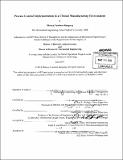| dc.contributor.advisor | Roy E. Welsch and Christopher L. Magee. | en_US |
| dc.contributor.author | Rangaraj, Dhanya Cumbum | en_US |
| dc.contributor.other | Leaders for Global Operations Program. | en_US |
| dc.date.accessioned | 2013-09-24T19:36:59Z | |
| dc.date.available | 2013-09-24T19:36:59Z | |
| dc.date.copyright | 2013 | en_US |
| dc.date.issued | 2013 | en_US |
| dc.identifier.uri | http://hdl.handle.net/1721.1/81013 | |
| dc.description | Thesis (M.B.A.)--Massachusetts Institute of Technology, Sloan School of Management; and, (S.M.)--Massachusetts Institute of Technology, Dept. of Mechanical Engineering; in conjunction with the Leaders for Global Operations Program at MIT, 2013. | en_US |
| dc.description | Cataloged from PDF version of thesis. | en_US |
| dc.description | Includes bibliographical references (p. 67-68). | en_US |
| dc.description.abstract | Amgen is shifting certain drugs from traditional vial and syringe primary containers to more patient friendly delivery devices known as combination products. Combination products are defined by the combination of a medical device and drug into a single entity. These new products are accompanied by new regulations and new production processes. Traditional drug manufacturers are required by the FDA to embrace certain practices traditionally pertinent to medical devices. As Amgen seeks to integrate these device processes into its business processes, additional quality procedures are necessary to control and improve the new production processes. This thesis seeks to examine process control techniques in the clinical manufacturing organization in an attempt to understand and improve the current new processes. A control plan was developed based on risk inputs, observational run data, and batch release requirements. A data collection process was then implemented and data was analyzed in control charts and aggregated defect rate analysis. Results show that 1) the overall assembly process appeared to stabilize over the period of analysis, 2) although processes were within specification limits, none of the inspection processes were entirely within statistical control, and 3) investigative avenues for out of control processes are suggested as a part of the control feedback loop. Recommendations regarding managerial challenges in implementing a quality control system are also suggested. The opinions expressed herein are solely those of the author and do not necessarily reflect those of Amgen Inc. | en_US |
| dc.description.statementofresponsibility | by Dhanya Cumbum Rangaraj. | en_US |
| dc.format.extent | 78 p. | en_US |
| dc.language.iso | eng | en_US |
| dc.publisher | Massachusetts Institute of Technology | en_US |
| dc.rights | M.I.T. theses are protected by
copyright. They may be viewed from this source for any purpose, but
reproduction or distribution in any format is prohibited without written
permission. See provided URL for inquiries about permission. | en_US |
| dc.rights.uri | http://dspace.mit.edu/handle/1721.1/7582 | en_US |
| dc.subject | Sloan School of Management. | en_US |
| dc.subject | Mechanical Engineering. | en_US |
| dc.subject | Leaders for Global Operations Program. | en_US |
| dc.title | Process control implementation in a clinical manufacturing environment | en_US |
| dc.type | Thesis | en_US |
| dc.description.degree | S.M. | en_US |
| dc.description.degree | M.B.A. | en_US |
| dc.contributor.department | Leaders for Global Operations Program at MIT | en_US |
| dc.contributor.department | Massachusetts Institute of Technology. Department of Mechanical Engineering | |
| dc.contributor.department | Sloan School of Management | |
| dc.identifier.oclc | 857790208 | en_US |
